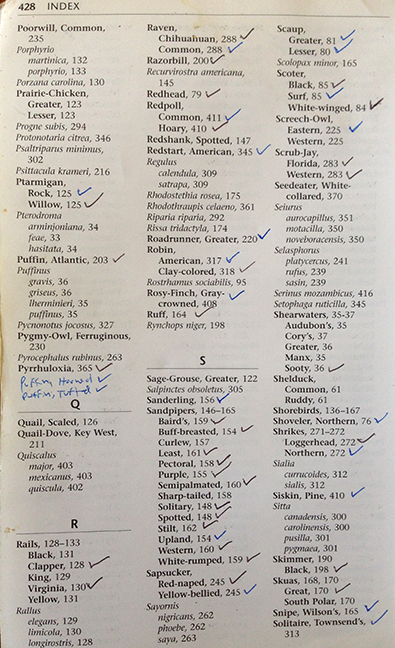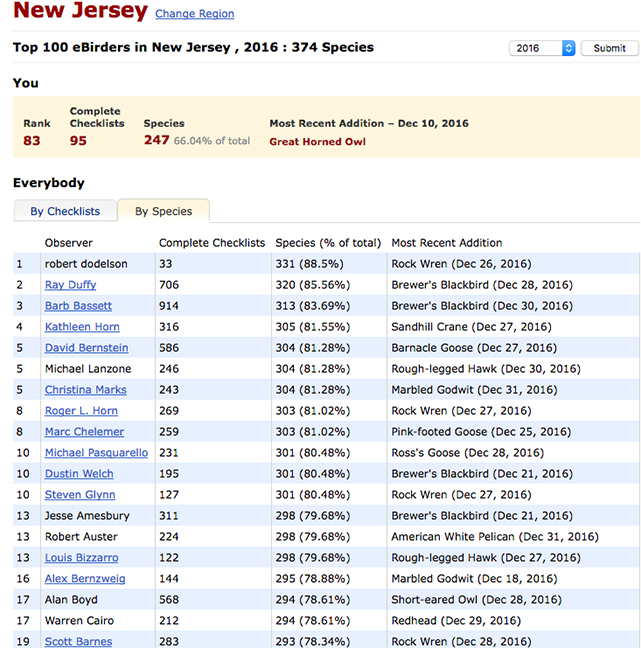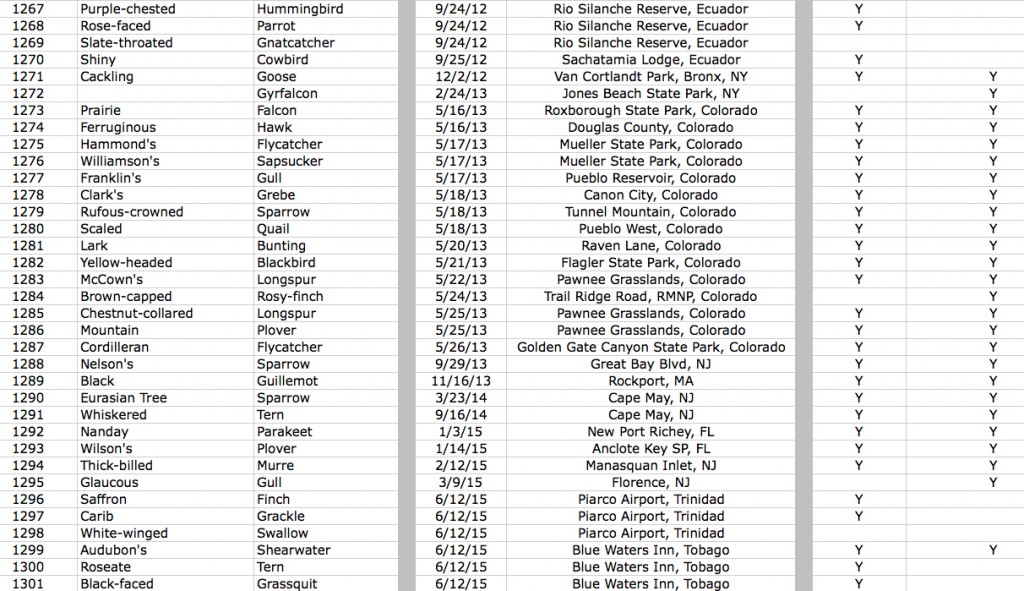We birders live in an age of lists. For better or worse. Life lists, state lists, county lists, ABA lists, year lists, month lists, photo lists, big day lists, yard lists. We all keep them to varying extents. I even met one famous birder who keeps a list of how many birds he photographs with each camera. (yes, he really does!) Sometimes I get asked by beginning birders: what is the best way to keep track of your lists? My answer is not simple, because it depends on how committed you are to your lists, and for most of us, that evolves over time. It is likely that my history with listing parallels that of many other birders, so I will share my experiences here.
I suspect that many birders begin by using the checklists at the back of our field guides (especially those of us who grew up in an age less dominated by hand-held electronic devices). When we see a new species, immediately we check it off, either in the actual checklist or by putting a mark or some notes next to the image of that species. That’s as simple as it gets. The problem that eventually occurs using this system, is that first of all, you don’t know exactly how many species you have seen unless you religiously keep a running tally, which is hard to do (did I remember to include the Iceland Gull that I saw last week in the running total?). Secondly, at some point you will travel outside of the boundaries of your local field guide and will be seeing a whole new group of birds that will require a whole new field guide and a whole new checklist. For me, this first happened when I took my first trip out west, bought a Sibley guide of western US birds, and now was seeing Elegant Trogon and Painted Redstarts and Spotted Owls that were not in my Sibley Eastern Birds field guide. And when I traveled outside the US you can imagine that keeping a life list in this way became untenable. A final problem is that if you want to keep year lists or state lists, using the standard field guide checklist system just won’t work.

A page from my Eastern Sibley Guide index. It worked well as a checklist for a while, but after I started seeing Horned and Tufted Puffins in Alaska and other species not in the Eastern Guide, it became clear that this system was too limited.
A major improvement for keeping track of bird sightings came with the advent of eBird. If eBird is used to keep track of your sightings, eBird will do all of the record keeping for you. Up-to-the-minute lists are generated for all your sightings, they are archived, and you can even look up how many species you have seen in any location within any timeframe (How many species have I seen in Sandy Hook since 2010?) As a ‘bonus’, you can look up how your sightings list ranks compared to other eBirders (Hey, I have the sixth highest list for the state for this year!). So eBird is great for keeping track of multiple lists, with the only limitation being your willingness to enter every trip into the database. From my perspective, I used to put all my sightings into eBird, until it felt more like work; it became a task that I really didn’t want to do yet felt compelled to do for completeness and it eventually detracted from the overall birding experience. Perhaps more importantly, I felt the inevitable competitive juices flowing and started birding just to climb higher up the county or state lists instead of going places that I simply enjoyed birding regardless of whether I was likely to see a new bird for the county or state. A final minor complaint about eBird is that I like having my records in my own possession, and with eBird the records survive somewhere on the Cornell campus computer system. It might be possible to download them to my own computer, but that is beyond my abilities. Nonetheless, eBird has grown immensely popular and will remain the keeper of records for the near future.

NJ eBird top 100 rankings for 2016. eBird top 100 rankings can be generated easily, selecting for specific years (or for all time), and for a series of different geographical locations (world, country, state, county, and even for specific birding hotspots).
All of this begs the question of how I maintain my records. I decided long ago to simply keep an Excel checklist file of my first records. I have separate columns for the bird’s name, the location where it was first sighted, the date, and two additional columns, where I add a ‘Y’ in one column if the bird was photographed and a ‘Y’ in the second column if it was seen in the ABA area. In this way, this single file keeps track of all of my lifers, ABA birds, and photographed birds. It is easily searchable (have I seen a Black-throated Sparrow, and if so, where and when?) and sortable (how many wren species have I seen?). By sorting on the dates, I can see what my 500th or 1,000th or 1,500th species was in the event that it becomes important. I realize that my system is not for everybody, but it works well for me. It gives me the satisfaction of knowing how many birds I’ve seen and photographed without feeling drawn into competitive birding and excessive recordkeeping. I wouldn’t be surprised if at some point in the near future that even this relatively simple method comes to a screeching halt too and I reach a stage where the numbers won’t matter at all.
